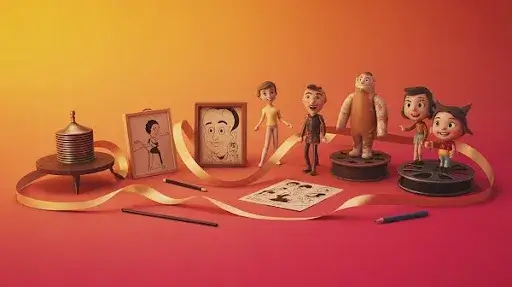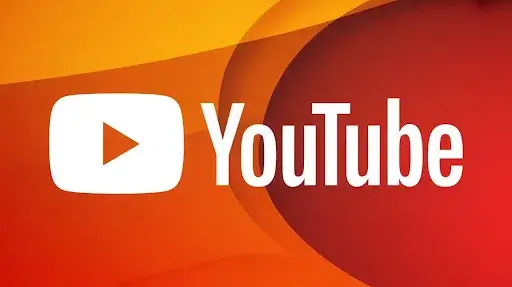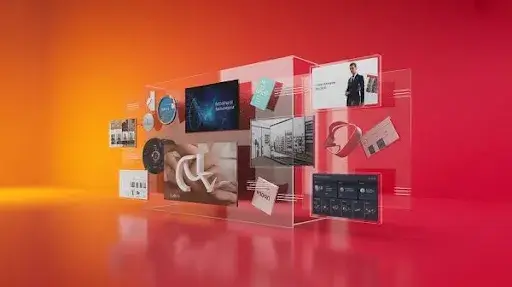Some stories don’t need actors, cameras, or sets to leave a mark. Animation proved that long before Hollywood had its first studio lot. What started as flickering drawings and visual tricks is now driving billion-dollar franchises, 3D animation services, anime culture, and video games with lifelike character modeling and hair simulation.
Before Pixar, before CGI, before frame-by-frame animation cost savings were even a thing, people were already trying to make drawings move.
This isn’t a recycled recap of “once upon a time, animation was invented.” You’re getting the story behind the screens, the roots, the forgotten experiments, the animation history facts that most blogs skip, and the fun animation trivia that still surprises industry experts.
How Early Civilizations Sparked the Process of Animation
People assume animation began in studios. It didn’t. The instinct to animate came centuries before cameras existed.
Archaeologists found a 5,200-year-old pottery bowl in Iran featuring a goat in repeated phases of movement, eating from a tree. When the bowl is rotated, the sequence plays like an ancient flipbook. Egyptians did something similar. In the tomb of Beni Hasan, there’s a mural of wrestlers captured in multiple poses, each painted to show motion from frame to frame.
Nobody was talking about animation studios, tools, or production back then. Yet the impulse to create motion through imagery was already driving artistic expression.
These animation history facts show something big: animation didn’t start in cinema. It started in the urge to tell a moving story without speech.
The First Real Animators Weren’t Using Cameras
Jump to the 19th century. Long before 2D animation services were commercial, inventors were using optical illusions to simulate movement.
Devices like:
- Zoetrope: a spinning cylinder with slits and sequential drawings
- Phenakistiscope: spinning discs viewed through small openings
- Praxinoscope: similar concept with mirrors for a clearer picture
These weren’t toys. They were stepping stones in the process of animation, proof that people didn’t wait for Hollywood to design techniques. They hacked visuals into motion using physics and repetition.
This is where animation industry milestones really begin.
Émile Cohl and the First Known Animated Short
In 1908, French cartoonist Émile Cohl created Fantasmagorie, a 1-minute 17-second hand-drawn animation considered the first of its kind. He sketched each frame on paper, shot them individually, and produced something audiences hadn’t seen before.
This is why Cohl is often called the “father of animation.” Not every source agrees on labels, but his influence is undeniable. His short film didn’t use sound, color, or characters people recognized, yet it shaped an entire industry.
Around the same time, Stuart Blackton was experimenting too, creating animated shorts for New York’s Vitagraph Company. Some researchers credit him as the first animator. Either way, both names reshape animation history facts beyond the usual “Disney did it first” narrative.
Gertie the Dinosaur: The First Animated Celebrity
In 1914, Winsor McCay released Gertie the Dinosaur. It wasn’t just an interesting fossil of animation history, it was the first animated character with a personality. Gertie smiled, moved, reacted, and performed. People felt something. And the film actually made money.
Gertie also changed the process of animation. McCay used keyframes, timing, and emotional movement, ideas still used in 2D and 3D animation services today.
How Walt Disney Sparked the Next Era
Before he launched a global empire, Walt Disney was experimenting with short films using only a handful of animators. His early team, just four artists, worked on Steamboat Willie in 1928, the short that introduced synchronized sound and Mickey Mouse.
But the game changed with Snow White and the Seven Dwarfs in 1937. Disney mortgaged his home to finance production. The movie cost $1.5 million, took three years to complete, and required:
- 32 animators
- 1032 assistants
- 107 inbetweeners
- 10 layout artists
- 25 background artists
- 65 visual effects animators
- plus support staff most people don’t even mention
People didn’t expect hand-drawn animation to compete with live-action. Then Snow White made history.
Here’s a fun piece of Walt Disney animation trivia: he won one normal Oscar and seven miniature Oscars in 1938, one for Snow White and seven for each dwarf. Nobody else has ever accepted awards like that.
Animation Studios Expanded the Whole Medium
Once Disney’s commercial success proved animation could sell, animation studios across the globe evolved fast.
Key milestones include:
- 1933 – Three Little Pigs cost only $22,000 to create
- 1940 – Fantasia became the first commercial film released with stereophonic sound
- 1950s – Simon & Garfunkel once performed under the stage name “Tom & Jerry”, and the cartoon almost used the names Jasper and Jinx instead
- 1991 – Beauty and the Beast became the first animated movie nominated for Best Picture at the Oscars
- 1995 – Toy Story became the first feature-length 3D animated film, fully CGI
That last milestone shifted everything. 3D animation services became the new frontier. Traditional frame-by-frame work didn’t disappear, but computer-generated storytelling reshaped budgets, teams, and timelines. Studios could finally hit frame-by-frame animation cost savings by blending tech with manual work.
Animation Trivia Most People Miss
Some facts about animation get recycled nonstop. These don’t.
The Most Expensive Animated Film Ever
People assume it’s Frozen 2, but the real record often goes to Tangled with a production cost of around $260 million over six years.
Japanese Anime Health Incident of 1997
In December 1997, an episode of Pokémon caused seizures in hundreds of viewers in Japan due to rapid red-blue light flashing. That changed global animation safety guidelines permanently.
Hair Simulation Nearly Broke Systems
Animation character modeling hair simulation is still one of the toughest challenges in CGI. Pixar spent years building technology just to animate Merida’s hair in Brave. DreamWorks struggled with similar tech for Shrek 2.
Burps That Made the Final Cut
Cameron Diaz burped during a recording session for Shrek. Writers loved it so much, they added the scene where Fiona belches in front of Shrek.
How Animation Techniques Keep Evolving
Traditional animators used sequential drawings. Then came cels, stop motion, and rotoscoping. Today, studios mix motion capture, CGI sculpting, 3D modeling, and hybrid rendering.
2D animation services still thrive in explainer videos, commercials, anime, and educational content. 3D animation services dominate film, gaming, simulation, medical visuals, and advertising.
Even the process of animation changes across formats. For 3D, rigs and wireframes replace hand-drawn frames. Lighting, texturing, environment design, hair simulation, facial capture, and GPU rendering define output quality.
Yet one simple concept never changed, give still images the illusion of life.
Animation Industry Milestones You Don’t Hear Often
You already know the big ones. Here are the underrated ones that shaped production standards:
- Stop motion brought physical storytelling before CGI
- Rotoscoping gave characters realism using live-action tracing
- Stereophonic sound in Fantasia changed music in animation
- CGI breakthroughs started with experimental sequences in Tron (1982)
- 3D animated shorts built the path for Toy Story long before it was released
- Digital ink and paint helped animators retire bulky cels
- Streaming platforms created demand for animated documentaries, adult animated series, and motion graphics
Animation studios no longer rely on one style to survive. Today, they mix software, illustration, motion capture, and pipeline automation.
Animation Didn’t Just Enter Pop Culture, It Built It
Characters like Mickey Mouse, Bugs Bunny, Tom and Jerry, Goku, and Woody didn’t stay in film. They shaped fashion, merchandise, comedy, music, and even brand mascots.
And here’s another lesser-known fact, the first cartoon character wasn’t Mickey. The oldest still-recognized Disney character is Pete, who appeared three years earlier in Alice Solves the Puzzle (1925).
The Rise of Anime and Its Global Pull
Japan didn’t follow anyone else’s playbook. Before streaming platforms turned Naruto and Attack on Titan into global hits, local artists were already experimenting with short animated stories pulled from folklore, sci-fi, comedy, and everyday struggles.
Astro Boy marked the moment things shifted. Tezuka Osamu, who many credit as the architect of the modern anime tone, launched it in the 1960s. Instead of slapstick and exaggerated gags, he leaned on plot, emotion, and character conflict. That one series shaped how anime would behave for decades.
Then came an incident nobody in the industry forgets, the Japanese anime health incident of 1997. A Pokémon episode flashed red and blue lights so rapidly that hundreds of children watching at home experienced seizures. The fallout forced broadcasters to change rules for visual intensity and animation safety.
Anime also did something Hollywood didn’t expect, it showed that 2D animation services could still compete with 3D animation services. Fans weren’t chasing hyperrealism. They wanted connection, pacing, and story. Style became a selling point, not a limitation.
How Technology Reshaped the Process of Animation
Animation didn’t retire its pencils, it plugged them into computers. As digital tools took over, the process of animation changed from the ground up.
Some of the biggest shifts included:
- Frame-by-frame drawing stayed alive in anime and independent shorts.
- Digital ink and paint replaced traditional cels, cutting production time.
- CGI opened the door for 3D modeling, character rigs, lighting, and texture work.
- Motion capture saved animators from redrawing every step or facial shift.
- Hair simulation and physics tools became new benchmarks for realism in films like Frozen and Brave.
These upgrades shaved days off production cycles but came with trade-offs. Studios had to hire artists who could also navigate software, rendering systems, and pipeline tools. Budgets shifted from paper supplies to licensing fees and hardware.
The trade paid off. Animated movies began holding their ground against live-action blockbusters instead of playing second tier.
The First Feature-Length 3D Animated Film Changed Everything
Toy Story didn’t just come out in 1995, it detonated every assumption about animated cinema. As the first feature-length 3D animated film built fully with CGI, it showed that computers could carry a story without losing charm, humor, or heart.
Pixar couldn’t treat it like a visual test. The film had to feel complete. And it did. After that, animation studios everywhere, Disney, DreamWorks, Sony, smaller independents, rebuilt their pipelines around 3D animation services.
Toy Story still shows up in conversations about animation industry milestones because it didn’t replace 2D. It forced everything around it to rethink what counted as animation.
Fun Animation Trivia That Still Surprises People
Not every breakthrough comes from big budgets. Some of the strangest and most-loved facts about animation came out of chance, mistakes, and personality.
Walt Disney Animation Trivia People Usually Miss
- Steamboat Willie nearly stayed unreleased. Disney had to push through distribution rejections to get it seen.
- Mickey Mouse wasn’t his first character. Oswald the Lucky Rabbit came earlier, but losing the rights forced him to create someone new.
- Animators occasionally slipped versions of themselves into background crowds and side shots.
Other Fun Animation Trivia
- Shrek was almost voiced by Chris Farley. He recorded most of the lines before his death. Mike Myers ended up restarting the character from scratch.
- Pixar’s famous Luxo Jr. lamp came from a doodle sitting in early design meetings.
- Bugs Bunny’s line, “What’s up, Doc?” came straight from a Texas phrase one animator used jokingly.
It’s moments like these that remind people how personal animation can feel, even when hundreds of people are working on a single film.
Animation Studios Competing Across Borders
By the 2000s, the industry was no longer a one-country show. Disney and Pixar were merging. DreamWorks was pushing out Shrek, Madagascar, and Kung Fu Panda. Studios across Europe and Asia started gaining visibility with their own tones and production methods.
Some held onto 2D animation services as a differentiator. Others invested heavily in CGI pipelines. Stop motion, assumed to be fading out, returned with films like Coraline and Kubo and the Two Strings.
Then streaming platforms rewired the playing field. Netflix, Hulu, and Prime Video began producing original animated content. Shows that would never have landed theatrical releases suddenly had an audience baked in.
That shift created new animation industry milestones:
- Adult animated shows gained a mainstream slot outside late-night TV.
- Animated documentaries found real audiences.
- International joint productions became normal instead of rare.
Animation stopped living in theater schedules and weekend TV blocks. It stretched into every screen people use.
Frequently Asked Questions
What was the first animated film?
Fantasmagorie by Émile Cohl in 1908. It ran just over a minute and still changed everything.
Who is considered the father of animation?
Émile Cohl is the most commonly credited, though Winsor McCay and Stuart Blackton influenced the field heavily.
What was the first feature-length 3D animated film?
Toy Story in 1995, the first fully CGI film created by Pixar.
What is the most expensive animated movie ever made?
Tangled is the name most sources cite, with a budget reported around $260 million.
Why do many cartoon characters only have four fingers?
Fewer fingers cut drawing time in frame-by-frame animation and help studios save on cost without making characters look odd.
What was one of the oddest moments in animation history?
The Japanese anime health incident of 1997, when a Pokémon episode caused seizures due to rapid flashing scenes.
Do 2D animation services still hold value when 3D dominates film?
Absolutely. 2D animation services still drive explainer content, anime, educational videos, ads, and stylized projects.
Final Words
Animation isn’t some side branch of entertainment. It’s a problem-solver, a storyteller, a teaching tool, and a marketing asset. From drawings on clay bowls to advanced hair simulation in feature films, the medium keeps reinventing itself without losing its core idea, creating movement from stillness.
For brands, educators, and storytellers, animation delivers clarity and memory in ways text and photos can’t. Businesses that invest in 2D or 3D animation services get better reach, stronger recall, and cleaner communication.
Studios like Prolific Studio are built around that purpose, turning complex material into something people understand and enjoy. And if history has proved anything, the next wave of animation history facts is already forming behind the scenes.
Related Articles:







